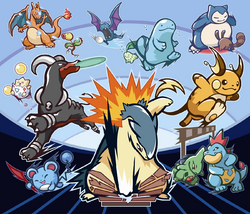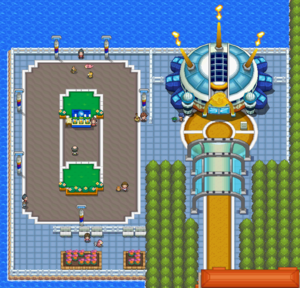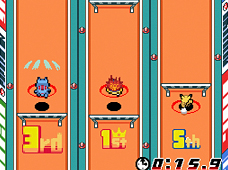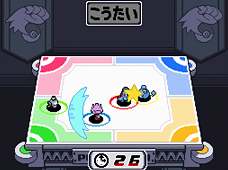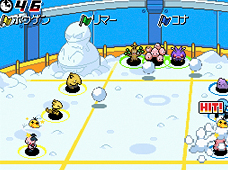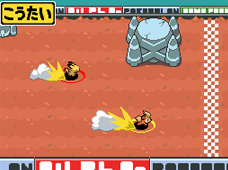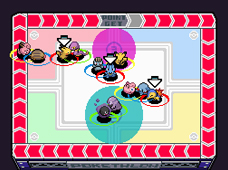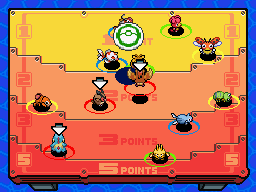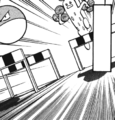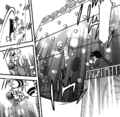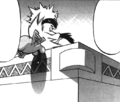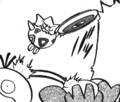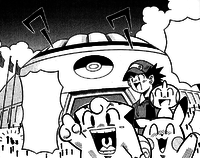Pokéathlon: Difference between revisions
m (→In the manga) |
|||
| Line 527: | Line 527: | ||
</gallery> | </gallery> | ||
===In the Pokémon Pocket Monsters manga=== | ===In the Pokémon Pocket Monsters manga=== | ||
[[File:Pokéathlon Dome PMHGSS.png|thumb|200px|Pokéathlon in Pocket Monsters HGSS]] | |||
The Pokéathlon appeared in the [[PMHGSS01|first chapter]] of {{OBP|Pocket Monsters HGSS|Kosaku Anakubo}}. Unlike the games, [[Professor Elm]] was in charge of the Pokéathlon instead of [[Maximo]]. | The Pokéathlon appeared in the [[PMHGSS01|first chapter]] of {{OBP|Pocket Monsters HGSS|Kosaku Anakubo}}. Unlike the games, [[Professor Elm]] was in charge of the Pokéathlon instead of [[Maximo]]. | ||
Revision as of 02:45, 10 January 2015
Pokéathlon (Japanese: ポケスロン Pokéthlon) is a type of competition involving Pokémon racing and similar athletic competitions, in the manner of Olympic track and field competitions. It was introduced in Pokémon HeartGold and SoulSilver. The Pokéathlon Dome, where the competitions are held, is north of Goldenrod City, next to National Park.
The Pokéathlon is handled similarly to Pokémon Contests and Super Contests in the Hoenn and Sinnoh regions, as a sidequest to complete while the player challenges the Gyms and the Pokémon League. Like in Contests, four competitors participate at once; however, each uses a team of three Pokémon instead of only one. The Pokémon and Trainers that take part are known as "Pokéathletes".
Like the five stats introduced for Contests, five additional stats were added for the Pokéathlon: Speed, Power, Skill, Stamina, and Jump. Like the Contest conditions and battle stats, a Pokémon's performance stats are affected by its Nature (more directly so, like the battle stats, than the condition). Using the Apriblender, Aprijuice can be made and used to boost or lower these Performance Stats.
By winning events in the Pokéathlon, the participating Pokémon will earn medals for their species. Their Trainers will earn points for the competition based on how well the team did, if they qualified for any of the several bonuses, and a win will earn their Trainer an additional 100 points (300 points in the Supreme Cup or 500 points in Link Pokéathlon), all which can be spent on prizes at the Salon Shop or Data Cards with which the player may see records of various actions, course wins and losses, and multiple other statistics in the Pokéathlon Dome. Beating the records for all 10 of the events in the Pokéathlon earns a Trainer star in HeartGold and SoulSilver.
Once the National Pokédex is obtained and the player has talked with Magnus in the Friendship Room, the Supreme Cup is unlocked. The opponents are slightly harder, but Trainers who get in first place here will earn a bonus 300 points instead of the regular 100.
Events
Hurdle Dash
Hurdle Dash (Japanese:ダッシュハードル Dash Hurdle) pits the twelve competing Pokéathletes against one another in a race down a track, with hurdles standing every so often for the Pokémon to jump over.
The player controls all three of the Pokémon simultaneously. The three Pokémon automatically run forward. Tapping a Pokémon with the stylus will cause it to jump, with Pokémon tapped just before jumping a hurdle gaining a speed boost. Pokémon that have a speed boost will have a blue wind tunnel appear around them. The boosts stack, and a Pokémon that gets four such boosts will have its wind tunnel turn red; this indicates the maximum possible speed boost. The boost lasts until the Pokémon either crashes into a hurdle or finishes the course. It is even possible for a Pokémon to bounce off a hurdle when it would ordinarily crash-land by tapping the Pokémon the instant it touches the hurdle — in this manner, it is not slowed down and may even get a speed boost.
Once all Pokémon have crossed the finish line, the event is over, and the finish times for the three Pokémon are added together to obtain a total time for each team. Scoring a total time of 100 seconds or less will give the player the 1st place record for the event, and scoring 80 seconds or less will give the player a Potential trophy.
Athlete Points for the event are calculated as 11500 divided by the total time in seconds.
According to "The Official Pokémon Johto Guide & Johto Pokédex", the top six recommended Pokémon are Golbat, Crobat, Jumpluff, Voltorb, Skarmory, and Aerodactyl. The Hurdle Dash appears as the first course in the Speed competition and as the final course in the Jump competition.
| Performance | Effect |
|---|---|
| Speed | Movement speed |
| Jump | Length of jump |
| Skill | Acceleration rate |
Ring Drop
Ring Drop (Japanese:リングアウトファイト Ring-Out Fight) is somewhat based on sumo, however, it is between four Pokéathletes at a time, rather than two. Pokémon compete by tackling each other, trying to knock opponents out of the ring while staying in the ring themselves.
One Pokémon is controlled at a time. Flicking the stylus will cause the Pokémon to do a tackle in that direction. If it hits an opponent, the opponent is pushed back some distance, which is determined by the tackler's Power stat, the opponent's Stamina stat, and the opponent's fatigue level. Tapping the Pokémon with the stylus will cause it to jump in place, with little lateral movement, but if it lands on an opponent the opponent is launched quite far. Pokémon also get fatigued when they are hit by tackles, which decreases their resistance to launching. A Pokémon who is very fatigued will start to sweat, and a Pokémon who is extremely fatigued will faint, becoming immobile and losing a great deal of launch resistance for a few seconds. Pokémon can be switched out, but only when the Pokémon is near the team's starting corner. Pokémon who are switched out gradually have their fatigue restored. When a Pokémon falls off the ring or is switched out, the next Pokémon takes its place, spawning in the team's corner. If a Pokémon has just spawned, it is immune to any form of contact with opposing Pokémon until either 2 seconds pass or it moves. This event lasts for 60 seconds.
Teams earn points by landing tackles and jumps, and by knocking opponents out of the ring. A tackle that hits a Pokémon earns 1 point, and a jump that lands on a Pokémon earns 2 points. An additional 10 points are scored if the attack knocked the opponent out of the ring. No points are deducted if a Pokémon is knocked out of the ring by an opponent, but if a Pokémon throws itself out of the ring, its team is penalised 10 points (to a minimum of 0). A score of 70 earns the player the 1st place event record, and a score of 100 earns the player a Potential trophy.
The score from these results is then multiplied by 1.5 (rounded down) to obtain the Athlete Points for the event. A player may not earn more than 200 Athlete Points even if they scored more than 134.
According to "The Official Pokémon Johto Guide & Johto Pokédex", the top six recommended Pokémon are Quagsire, Slowbro, Vileplume, Wobbuffet, Shuckle, and Ursaring. This is the first event in the Stamina competition, the only competition it is a part of.
| Performance | Effect |
|---|---|
| Speed | Movement speed |
| Power | Tackle power |
| Stamina | Endurance to attacks |
| Jump | Jumping distance, press power |
Snow Throw
Snow Throw (Japanese:シューティングスノー Shooting Snow) is an all-out snowball fight between the four teams of Pokémon, with each throwing snowballs at any of the members of the other three teams in order to knock them out for points.
All three Pokémon are controlled simultaneously. The three Pokémon cannot move around in this event, and can only create and throw snowballs. Tapping a Pokémon with the stylus will cause it to make a snowball, and flicking the stylus throws the snowball in the direction of the flick. If the snowball hits an opponent, the hit counter increases by one, and the opponent's fatigue goes up. Larger snowballs can be made by tapping multiple times before throwing; these do not give additional points, but fatigue opponents more if they hit. If a Pokémon's fatigue gets too high, it will faint, making it unable to do anything for a few seconds. Any snowballs that collide with each other destroy each other, regardless of size. This event lasts for 60 seconds.
Scoring is determined by the number of snowballs that make contact with the opponent's Pokémon. A total of 30 hits earns the player the 1st place event record, and a total of 55 hits earns the player a Potential trophy.
The number of hits is then multiplied by 3 to calculate the Athlete Point score for the event. A player may not earn more than 200 Athlete Points even if they scored more than 66 hits.
According to "The Official Pokémon Johto Guide & Johto Pokédex", the top six recommended Pokémon are Raichu, Machamp, Meganium, Tangrowth, Poliwrath, and Tyranitar. This event is the first in the Skill competition, the only competition it is part of.
| Performance | Effect |
|---|---|
| Power | Ability to KO opponent |
| Stamina | Ability to withstand being KO'd |
| Skill | Accuracy and Speed of throw |
Lamp Jump
Lamp Jump (Japanese:バウンドフィールド Bound Field) is a game similar to pachinko, only using the Pokéathletes themselves, rather than balls. Here, Pokémon must leap into the air towards a grid of lamps, touching as many as possible to score points while avoiding collisions with each other.
All three Pokémon are controlled simultaneously. The player must drag the Pokémon down to the bottom of the screen with the stylus, then release to catapult it high into the air, where lamps shine. A lamp that is touched is put out and cannot be scored from again for a while; all lamps are re-lit every 8 seconds. The danger in this event comes not from opponents, but from the player's own Pokémon — if two Pokémon collide (either in midair or on the ground), they are both stunned and cannot jump for several seconds, though they can still touch lamps if already in midair. Pokémon with an extremely high Jump stat that are launched very high may bounce again automatically after their first jump, though this counts as a separate jump for scoring purposes. This event lasts for 60 seconds.
Each lamp gives points equal to one plus the number of lamps already touched in that jump, to a maximum of five (so, for example, touching 8 lamps in one jump will grant 1 + 2 + 3 + 4 + 5 + 5 + 5 = 25 points total). Scoring 350 points earns the player the 1st place event record, and scoring 500 points earns the player a Potential trophy.
The score is then divided by 3.5 to get the Athlete Point score for the event.
According to "The Official Pokémon Johto Guide & Johto Pokédex", the top six recommended Pokémon are Scyther, Pikachu, Ledian, Bellossom, Ambipom, and Politoed. This is the first event in the Jump competition, which it is exclusive to.
| Performance | Effect |
|---|---|
| Jump | Height of jump |
| Power | Teammate collision bounce-length |
| Stamina | Speed of recovery after KO |
| Skill | Accuracy of jump |
Relay Run
Relay Run (Japanese:チェンジリレー Change Relay) has Pokéathletes race each other around a circular track, trying to complete as many laps as they can in the allotted time.
One Pokémon is controlled at a time. Pokémon are moved by flicking them towards the right with the stylus. A set of obstacles will be randomly placed on the track that the Pokémon must avoid. These obstacles are always placed such that a Pokémon never has a clear, perfectly straight path from one lap to the next. Small patches of rocks will greatly slow any Pokémon that crosses them, and Pokémon who hit the larger gray rocks will bounce backwards off them. In addition, as a Pokémon runs, it gets fatigued. When its fatigue is high enough, it starts to sweat and becomes much slower. If its fatigue gets even higher, the Pokémon faints, becoming immobile for a few seconds. Fatigue is also gained upon collision with another Pokémon, which also stuns both Pokémon for a moment, though the Pokémon in front is stunned for a shorter time (and afterwards, it gets a small boost). A Pokémon can be switched out at any time (except when fainted), which resets its fatigue and puts the next Pokémon in its place. This event lasts for 90 seconds.
Scoring is determined by the total number of laps run. Running 12 laps will earn the player the 1st place event record, and running 16 laps will earn the player a Potential trophy.
The number of laps run is then multiplied by ten to get the Athlete Point score for the event (e.g. 15.5 laps becomes 155 points). A player may not earn more than 200 Athlete Points even if their Pokémon ran more than 20 laps.
According to "The Official Pokémon Johto Guide & Johto Pokédex", the top six recommended Pokémon are Togepi, Oddish, Venonat, Electrode, Rapidash, and Dratini. Relay Run is the third and final course of the Speed competition and the second course of the Stamina competition.
| Performance | Effect |
|---|---|
| Speed | Movement speed |
| Skill | Acceleration of dash |
| Power | Damage to an opponents' Stamina by a collision |
| Stamina | Running endurance and resistance to collision damage |
Block Smash
Block Smash (Japanese:ブレイクブロック Break Block) sets four Pokéathletes, one from each team, against a stack of ten cement blocks. The Pokémon must demonstrate its might by breaking through them as quickly as possible.
One Pokémon is controlled at a time. The blocks can be broken by tapping them on the touchscreen, with the Power stat determining the number of times each block must be tapped before breaking. Breaking blocks raises a Pokémon's fatigue based on its Stamina and Skill. Dangerously high fatigue is indicated by the "switch" button blinking red. If a Pokémon gets too fatigued, it faints for a few seconds, during which it cannot break blocks or switch out. Switching out a Pokémon restores its fatigue over time. Also, each block has one or two small cracks on it. Tapping these cracks will destroy multiple blocks at once and display a blue fist for a moment. If the player taps multiple cracks in succession, the Pokémon will radiate a blue aura (known as Tension) for a while which will affect the entire team. If even more cracks are tapped, the aura will turn red, indicating that Tension has maxed out and the selected Pokémon has entered into High Tension mode. During High Tension mode, the Pokémon no longer gains fatigue and is now capable of destroying multiple blocks per hit until it switches out or a limited amount of time has passed (after which the Pokémon immediately has high fatigue). This event lasts for 30 seconds.
Score is determined directly by the number of blocks broken. Breaking 80 blocks earns the player the 1st place event record, and breaking 130 blocks earns the player a Potential trophy.
Athlete Points for the event are simply equal to the number of blocks broken.
According to "The Official Pokémon Johto Guide & Johto Pokédex", the top six recommended Pokémon are Typhlosion, Steelix, Poliwrath, Nidoqueen, Muk, and Snorlax. Block Smash is the first course in the Power competition and the third in the Stamina competition.
| Performance | Effect |
|---|---|
| Skill | Efficiency (Stamina used per Hit) |
| Power | Ability to smash blocks (# of Hits to smash a Block) |
| Stamina | Endurance |
Circle Push
Circle Push (Japanese:プッシュサークル Push Circle) features all twelve Pokéathletes on the field at once. They must each attempt to stay inside of the circles projected onto the field, all while keeping others out.
All three Pokémon are controlled simultaneously. A Pokémon can be moved by dragging it with the stylus. There are six rounds, each shorter than the last, with several numbered circles. The goal of the event is have as many of your Pokémon as possible inside the circles at the end of each round, with smaller circles granting more points to each Pokémon inside them. Pokémon can try to push opponents out of the circles, with a high Power stat granting more pushing ability. However, pushing other Pokémon can make a Pokémon fatigued or temporarily faint if done too much. Pokémon can also be pushed off the stage entirely; if this happens, that Pokémon returns to the ring after the current round finishes.
In the first round, there is one large circle worth 1 point. The second and third rounds have two circles each, one worth 2 points and one worth 3 points. The fourth round has three circles, one worth 2 points, one worth 3 points, and one worth 5 points. The fifth and sixth rounds have three circles each, one worth 3 points and two worth 5 points. A total score of 40 points will earn the player the 1st place event record, and a score of 60 points will earn the player a Potential trophy. 66 points is a perfect score.
The number of points is then multiplied by 3 to get the Athlete Point score for the event. A perfect score will yield 198 Athlete Points.
According to "The Official Pokémon Johto Guide & Johto Pokédex", the top six recommended Pokémon are Gyarados, Nidoking, Azumarill, Machamp, Donphan, and Dragonite. This event is exclusive to the Power Competition, in which it appears second.
| Performance | Effect |
|---|---|
| Speed | Movement speed |
| Power | Pushing strength |
| Stamina | Endurance when pushing opponents |
Disc Catch
Disc Catch (Japanese:キャッチソーサー Catch Saucer) features the twelve Pokéathletes lined up on a small pier in the middle of the water, where they must catch discs that are thrown through the air at them.
All three Pokémon are controlled simultaneously. Dragging a Pokémon with the stylus moves it, and tapping a Pokémon causes it to jump. Discs are constantly thrown towards the pier. At first, one disc is thrown at a time and the discs move slowly, but later on the discs may fly quickly or multiple discs may be thrown at once. If a Pokémon jumps while a disc is flying above it, the disc is caught. The arena is striated with four regions, and catching a disc awards points based on which region it was caught in (the further the disc is allowed to travel before being caught, the more points are awarded for the catch). If a Pokémon moves into another Pokémon (friend or foe), the two Pokémon bounce off each other, being propelled a short distance that varies based on Power and Stamina stats. Pokémon can fall off or be knocked off the pier, returning to the field of play about 3 seconds after falling. Pokémon always respawn in the same place regardless of where they fall from, depending on their team color and where in the team order they were placed. This event lasts for 60 seconds.
Depending on the region the disc was caught it, teams score either 1, 2, 3, or 5 points per disc caught. Scoring 40 points earns the player the 1st place event record, and scoring 70 points earns the player a Potential trophy.
Conversion to Athlete Points for this event is rather complicated, and it is currently unknown exactly how it works (though it is certainly based on the total score). Some example scores, with corresponding Athlete Point scores:
Athlete Points(rounded down) = 30 + 120*points / (12.5+points)
- 0 points = 30 Athlete Points
- 1 points = 38 Athlete Points
- 2 points = 46 Athlete Points
- 3 points = 53 Athlete Points
- 4 points = 59 Athlete Points
- 5 points = 64 Athlete Points
- 6 points = 68 Athlete Points
- 8 points = 76 Athlete Points
- 9 points = 80 Athlete Points
- 10 points = 83 Athlete Points
- 11 points = 86 Athlete Points
- 12 points = 88 Athlete Points
- 13 points = 91 Athlete Points
- 14 points = 93 Athlete Points
- 21 points = 105 Athlete Points
- 30 points = 114 Athlete Points
- 31 points = 115 Athlete Points
- 34 points = 117 Athlete Points
- 41 points = 121 Athlete Points
- 42 points = 122 Athlete Points
- 43 points = 122 Athlete Points
- 45 points = 123 Athlete Points
- 49 points = 125 Athlete Points
- 50 points = 126 Athlete Points
- 62 points = 129 Athlete Points
- 63 points = 130 Athlete Points
- 67 points = 131 Athlete Points
- 68 points = 131 Athlete Points
- 71 points = 132 Athlete Points
- 88 points = 135 Athlete Points
- 90 points = 135 Athlete Points
- 110 points = 137 Athlete Points
According to "The Official Pokémon Johto Guide & Johto Pokédex", the top six recommended Pokémon are Fearow, Skarmory, Dodrio, Gyarados, Hitmonlee, and Dragonite. This is the second event in the Jump competition, the only competition it appears in.
| Performance | Effect |
|---|---|
| Speed | Movement speed |
| Jump | Height and duration of jump |
| Power | Ability to push opponents around |
Pennant Capture
Pennant Capture (Japanese:スティールフラッグ Steal Flag) brings the Pokéathletes into a sandbox-like area, where small pennant flags appear every so often. Pokémon must bring as many flags as possible back to the starting position in the allotted time.
One Pokémon is controlled at a time. Flicking the stylus causes a Pokémon move in that direction (and also to face that direction, which is relevant for stealing flags). Flags will appear and re-appear on the field in pre-set positions, generally forming paths that go along the two sides of the sandbox, as well as up the center. There are also obstacles on the field, as well as parasols that sometimes hide flags under them. Pokémon collect flags by running into them, and can hold a maximum of nine at a time. After collecting flags, the Pokémon must return to the start area to tag off the next Pokémon and deposit their flags, which will not count towards the score unless this is done. Pokémon can also collide with each other. If a Pokémon rams an opponent from behind, the rammed Pokémon is stunned for a moment and gives up to two flags to the attacker (if a Pokémon does not have enough flags, all its flags are given). If time runs out as a Pokémon is depositing its flags, all the flags will still count towards the score. This event lasts for 60 seconds.
Score is determined directly by the number of flags successfully deposited. Getting 35 flags earns the player the 1st place event record, and getting 50 flags earns the player a Potential trophy.
The number of flags is then multiplied by 3 to obtain the Athlete Point score for the event.
According to "The Official Pokémon Johto Guide & Johto Pokédex", the top six recommended Pokémon are Ledian, Clefairy, Alakazam, Meowth, Jolteon, and Sneasel. This event appears as the second event in the Speed competition and as the third event in the Skill competition.
| Performance | Effect |
|---|---|
| Speed | Movement speed |
| Skill | Turning difficulty |
| Power | Ability to KO opponents |
| Stamina | Ability to withstand being KO'd |
Goal Roll
Goal Roll (Japanese:スマッシュゴール Smash Goal) is in essence a four-way soccer match with three Pokémon on each team.
All three Pokémon are controlled simultaneously. Dragging a Pokémon with the stylus moves it, and flicking the stylus causes a Pokémon to dash in that direction. A ball starts in the center of the field; balls can be either small and white, or (less commonly) large and golden. Pokémon can either roll the ball slowly by moving into it, or perform a Power Shot by dashing into it. A Power Shot launches the ball farther, and being hit by a Power Shot will raise a Pokémon's fatigue depending on its Stamina, the shooter's Power, and how far the ball traveled before hitting the Pokémon. Fatigued Pokémon are more likely to be stunned by Power Shots (causing them to spin around, stunned). Pokémon with high fatigue will start to sweat, reducing their movement speed and eliminating their ability to dash. Pokémon with very high fatigue faint, becoming immobile for a few seconds. Fatigue is restored by standing still. Whenever a ball enters a goal, it disappears and a new ball is immediately placed on the field near the center. This event lasts for 90 seconds. 30 seconds from the end of the event, the timer on the top screen disappears and is replaced by the words "Second wind!", at which point a second ball is placed on the field and both balls are played simultaneously.
Pokémon score points for their team by being the last one to touch a ball before it enters the goal of an opposing team. One point is added for each goal scored with a white ball, while two points are added for a goal scored with a golden ball. Each time the ball goes in a team's goal, that team loses a point unless the team's score is currently zero. A score of 3 points earns the player the 1st place event record, and a score of 9 points earns the player a Potential trophy.
Score is converted to Athlete Points as follows:
- 60 Athlete Points regardless of score
- 5 Athlete Points per point scored
- 10 bonus Athlete Points for having a higher score than exactly one opponent
- 20 bonus Athlete Points for having a higher score than exactly two opponents
- 40 bonus Athlete Points for having a higher score than all opponents
A player may not earn more than 200 Athlete Points even if they scored more than 20 (assuming this is the highest of the four scores).
According to "The Official Pokémon Johto Guide & Johto Pokédex", the top six recommended Pokémon are Meganium, Raichu, Granbull, Hitmontop, Tangrowth, and Tyranitar. This is the third event in the Power competition and the second event in the Skill competition.
| Performance | Effect |
|---|---|
| Speed | Movement speed |
| Skill | Dribbling ability and endurance of Power Shot |
| Power | Power Shot Damage and ability to stop a Power Shot |
| Stamina | Resistance to Power Shot Damage and ability to recover from fatigue and fainting |
Bonus points
At the end of the Pokéathlon, the bonus points are calculated first. These consist of four different categories:
Challenge Bonus
The challenge bonus is a bonus that measures the "fighting spirit" of a Pokéathlon team. The lower the stats of a team, the higher this bonus. It is calculated as 75 minus the total number of stars on a team when unaffected by Aprijuice (even if the team has drank Aprijuice). Thus, a team consisting of Ho-Oh (19), Moltres (19), and Zapdos (19) will always earn 18 points (75 - 19 * 3 = 18). A team of 3 Arceus holding Draco Plates will yield the lowest possible score (75 - 23 * 3 = 6).
No-Miss Bonus
A Pokémon who fulfills the "No-miss" criteria in all three events earns a bonus 10 points for its team. In each of the events, it means the following:
- Hurdle Dash - no hurdles were broken by the Pokémon.
- Pennant Capture - no flags were taken from the Pokémon via tackling.
- Relay Run - the Pokémon never fainted - became too tired to run.
- Block Smash - the Pokémon never fainted - became too tired to smash blocks.
- Circle Push - the Pokémon was inside a circle in all six rounds.
- Goal Roll - the Pokémon never fainted from being hit by balls, and the Pokémon never shot a ball into its own goal.
- Snow Throw - the Pokémon never fainted as a result of having a snowball thrown at it.
- Ring Drop - the Pokémon was never knocked off the stage and never fainted.
- Lamp Jump - the Pokémon did not faint from colliding with another Pokémon.
- Disc Catch - the Pokémon did not fall off the stage.
Leading Score Bonus
This is a 20-point bonus given to the Pokémon with the highest individual score. If there is a tie, all Pokémon who tied are awarded the bonus, even if they are on the same team.
Effort Bonus
This is a 10-point bonus given to the Pokémon that did the most of a certain action, picked randomly from "dashing", "jumping", "tackling", and "failing". If there is a tie, all Pokémon who tied are awarded the bonus, even if they are on the same team.
Notable contestants
There are several contestants that are also encountered throughout the storylines of the Generation IV games. They are only encountered in the Supreme Cup.
Falkner
Falkner is the Gym Leader from Violet City. He competes in the Jump Course with his Swellow, Pidgeot, and Staraptor.
| Jump Course Supreme Cup | ||||
| ||||
| ||||
| ||||
Jasmine
Jasmine is the Gym Leader from Olivine City. She competes in the Stamina Course with her Steelix, Magneton, and Magnemite.
| Stamina Course Supreme Cup | ||||
| ||||
| ||||
| ||||
Kuni
Kuni is a Kimono Girl. She competes in the Skill Course with her Espeon, Umbreon, and Eevee.
| Skill Course Supreme Cup | ||||
| ||||
| ||||
| ||||
Maylene
Maylene is the Gym Leader from Veilstone City, in Sinnoh. She competes in the Power Course with her Lucario, Meditite, and Machoke.
| Power Course Supreme Cup | ||||
| ||||
| ||||
| ||||
Primo
Primo is a former television star. He competes in the Power Course with his Machamp, Rhydon, and Granbull.
| Power Course Supreme Cup | ||||
| ||||
| ||||
| ||||
Whitney
Whitney is the Gym Leader from Goldenrod City. She competes in the Speed Course with her Miltank, Clefairy, and Clefable. She also gives the player their uniform when they first enter the Dome.
| Speed Course Supreme Cup | ||||
| ||||
| ||||
| ||||
Link Pokéathlon
Four players can participate in a link Pokéathlon. There are four events with each course. Courses A-E offer two medals dependent on the name of the course. Course F does not offer any Medals but offers double the Athlete Points. Below are the courses and events for each course.
- A. Speed & Jump
- Hurdle Dash
- Lamp Jump
- Disc Catch
- Relay Run
- B. Jump & Skill
- Lamp Jump
- Disc Catch
- Pennant Capture
- Snow Throw
- C. Skill & Power
- Goal Roll
- Snow Throw
- Pennant Capture
- Block Smash
- D. Power & Stamina
- Block Smash
- Circle Push
- Goal Roll
- Ring Drop
- E. Stamina & Speed
- Relay Run
- Ring Drop
- Hurdle Dash
- Circle Push
- F. Master
- All random
In the anime
In A Marathon Rivalry!, the Pokéathlon was held in Camellia Town. Ash joined the competition using his Monferno and Pikachu for Disc Catch and Hurdle Dash, respectively. However, he lost to Daniel and his Snorlax in Hurdle Dash. Other events of the Pokéathlon were also shown in the episode via a poster.
| Trainer | Pokémon used in Disc Catch | Pokémon used in Hurdle Dash | Place | ||
|---|---|---|---|---|---|
| Daniel | 
|
Hitmonlee | 
|
Snorlax | Winner |
| Ash | 
|
Monferno | 
|
Pikachu | N/A |
Other competitors
 Mankey |
 Medicham |
 Weavile |
 Drowzee |
 Nuzleaf |
 Grumpig |
 Spoink |
 Glaceon |
 Stunky |
 Magby |
 Abra |
 Machoke |
 Luxio |
Events
In the manga
In the Pokémon Adventures manga
Gold went to the Pokéathlon to meet up with Lance and get information about Arceus for Professor Oak. He starts with the Skill Course, which he enters with Exbo, Polibo, and Aibo and succeeds in beating it. After that, he beats the Jump Course with Sudobo, Sunbo, and Togebo. Next, he tries the Stamina Course, which he beats with Exbo, Polibo, and Aibo again.
Gold's fourth challenge takes him to the Speed Course, where he is pit up against the top athlete Jet. Initially, Jet gets the upper hand in the first two challenges, but is eventually defeated in Relay Run, which gives Gold enough points to win. For his final challenge, Gold enters the Power Course with Aibo, Exbo, and Polibo. His opponents this time are three of the Elite Four, Bruno, Koga, and Will. They manage to easily win the first two rounds, but Gold ends up the victor in Block Smash by utilizing High Tension mode.
After Gold tells everyone the real reason why he came to compete, a Dragonite attacks the Pokéathlon Dome. Gold manages to defeat it and realizes that the Dragonite actually belonged to Lance, which meant that they were attacked before they could get to the Dome. Annoyed that Lance isn't coming after all, Gold takes the Dragonite for safe keeping and heads off to Ecruteak City.
Events
In the Pokémon Pocket Monsters manga
The Pokéathlon appeared in the first chapter of Pocket Monsters HGSS. Unlike the games, Professor Elm was in charge of the Pokéathlon instead of Maximo.
Trivia
- Since Diglett and Dugtrio have a maximum jump stat of one, they are incapable of jumping; in Lamp Jump they can't move at all, in Disc Catch they can only move around, and in Hurdle Dash they dig under the hurdles. This makes earning a Jump medal for these two species much more of a challenge than other species.
- Sunkern and Ditto are both relatively common Pokémon that are capable of maximum stars.
- Pokémon seen in the Pokéathlon which have not been seen before are not recorded in the Pokédex.
See also

|
This game-related article is part of Project Games, a Bulbapedia project that aims to write comprehensive articles on the Pokémon games. |
